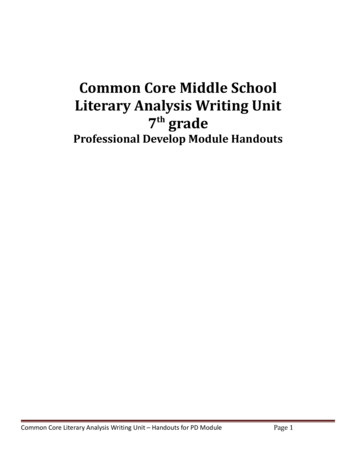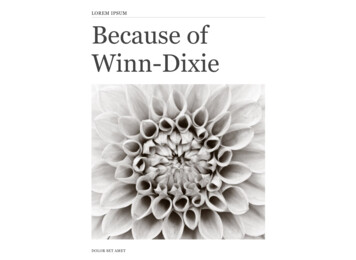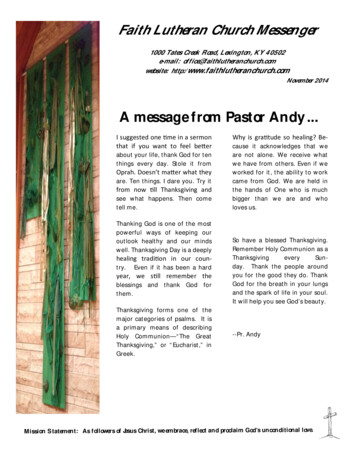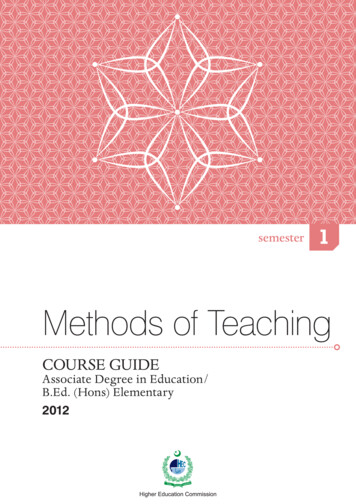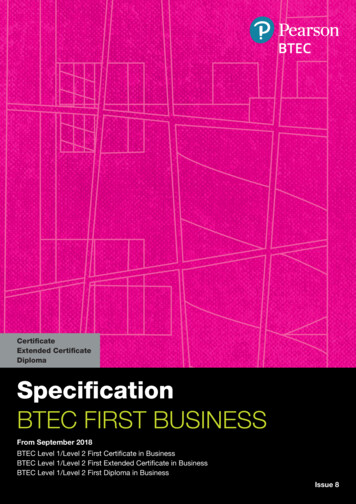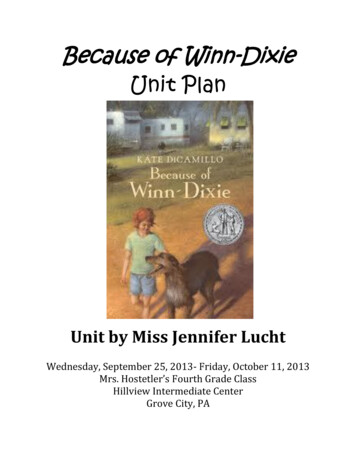
Transcription
Because of Winn-DixieUnit PlanUnit by Miss Jennifer LuchtWednesday, September 25, 2013- Friday, October 11, 2013Mrs.Hostetler’sFourthGradeClassHillview Intermediate CenterGrove City, PA
Table of ContentsSection One:13 Day Block PlanSection Two:General Unit Plan InformationSection Three:Daily Teaching ProceduresSection Four:AppendixStudent MaterialsAssessment ToolsTeacher Materials
Block Plan
Because of Winn-Dixie Block PlanMrs.Hostetler’sFourthGradeClassDay 1:09/25/13Day 2: 09/26/13Day 3: 09/27/13Introduction: Timeto share storiesabout petsReview HWReview HWVocabularyVocabularyInformation aboutKate DiCamillo,authorMini-Lesson: Pointof View andSee”TreeforPredictionsRead Chapters 3-4Character Analysisfor Franny BlockVocabularyActivity: Writeletter from Opal toher ��byEdgar GuestIntroduce ThemeActivity throughoutnovel“Wanted: rventionStart readingchapters 1-2HW: Finish readingchapters 1-2;Journal ResponseHW: Read Ch. 5;Character Analysesfor Opal and thePreacherHW: Read Ch. 8
Day 4: 9/30/13Day 5: 10/1/13Day 6: 10/2/13Day 7: 10/3/13Day 8: 10/4/13Review HWReview HWReview HWVocabularyQuizQuizContent IntegrationMini-Lesson:Thunderstormsand FloridaVocabularyRead Ch. 15-17Read Chapter zing/MainIdeaVocabularyMini-Lesson: Causeand ionHW: Read Ch. 11;Character Analysisfor Gloria DumpHW: Read Chapters12-13; CharacterAnalysis: OtisMini-Lesson:ThemeActivity:“Goal”Tree- decoratebottles and put agoal inside(inspired by GloriaDump’smistaketree)ReadingInterventionNo HWRead “TheCivilWar”poemandcompare to whatwe learn in thenovelReadingInterventionNo HWIntroduce ProjectOptionsReadingInterventionHW: Read Chapters20-21; choose aproject option
Day 9: 10/7/13Day 10: 10/8/13Day 11: 10/9/13Day 12:10/10/13Day 13:10/11/13Review HWRead Chapters 2427Collect ProjectsAnswer anystudent questionsPartyMini-Lesson:CharacterizationReview Story Plotand plot elementsRead Chapters 2223“Missing!”Activity10 Things aboutWinn-DixiePass out PartyInvitationsReadingIntervention(Use time toconference withstudents abouttheir projectselections)HW: Work onProject (dueWednesday)ReadingInterventionHW: Work onProject (duetomorrow)DiscussionQuestions inGroupsTestReview Themesthroughout bookProjectpresentations intable groupsTest Review:JeopardyNo HWActivity: Decoratepaper bag toMovie: Studentscomplete VennDiagram comparingmovie and novelNo HWHW: Study for Test
General Unit PlanInformation
Jennifer LuchtBecause of Winn-Dixie4th Grade Unit PlanI.II.Introductiona. Titlei. Because of Winn-Dixie by Kate DiCamilloii. Genre: Contemporary Realistic Fictionb. Grade Leveli. This unit plan is intended for Mrs.Hostetler’s4th Grade class at HillviewIntermediate Centerii. Interest Level: Grades 3-5c. Durationi. 13 class daysii. See block planContenta. Goalsi. The students will read the entire novel through independent and large-groupreading.ii. This unit will help the students to better develop their concepts of narrativeelements such as characters, points of view, plot, sequencing, and theme.iii. Through reading silently and out loud, students will improve their readingfluency.iv. The students will take away a greater understanding and appreciation ofothers around them. The students will gain an understanding that people aremolded by their backgrounds and experiences and it is important to get toknow others before making judgments about them.b. Conceptsi. Students will study narrative elements: characters, theme, plot, andnarration.ii. Students will practice reading comprehension strategies such as makingconnections, retelling, and sequencing,iii. Students will build their vocabulary throughout the unit.c. Vocabularyi. New Terms1. Exception: someone or something that is different from others2. Relieved: feeling relaxed or happy after a difficult situation haspassed; feeling relief3. Trembling: shaking uncontrollably (usually due to anxiety or fear)4. Prideful: having a feeling of superiority over others5. Pathological: extreme in a way that is not normal; extreme andirrational6. Abiding: continuing for a long time; not changing7. Notion: an opinion or idea
III.8. Manufactured: something that was produced/made (usually in afactory or by large machines)9. Melancholy: a sad mood or feelingii. Students will look for words with prefixes and suffixes to correspond to theircurrent spelling/vocabulary unit on prefixes and suffixesd. Skillsi. Story elements1. Characterization: character sketching, analyzing characterdevelopment2. Themes: big messages about life; students will identify and trackthemes throughout the novel3. Point of view and narration4. Plot: summarization, main idea, sequencing, plot elementsii. Making Connectionsiii. Making predictionsiv. VocabularyObjectives/Standardsa. Objectivesi. Overall1. Given a meaningful sentence with strong context support, TSWBATidentify word meaning for new vocabulary words to teachersatisfaction.2. Given a theme in the story, TSWBAT identify evidence of pertinentthemes while reading to teacher satisfaction.3. TSWBAT use prior knowledge and critical thinking skills to makepredictions as they read to teacher satisfaction.ii. Daily1. Day One:a. Given classroom instruction, TSWBAT correctly identify hestory.b. Through classroom instruction and introductory activities,TSWBAT identify the conflict of Opal being lonely in a newtown and identify her finding Winn-Dixie as a possible solutionto teacher satisfaction.2. Day Two:a. Given classroom instruction, TSWBAT accurately identify ointofview is important to the story.b. ersatisfaction.3. Day Three: Given classroom instruction on sequencing, TSWBAT workin a group to accurately sequence the events of two chapters inBecause of Winn-Dixie to at least 83% accuracy (10 out of 12 events inthe correct order).
4. Day Four: Given classroom instruction and reading in Because ofWinn-Dixie, TSWBAT identify causes to events in the story to teachersatisfaction.5. Day Five:a. Given classroom instructions and a visual dients”necessaryforathunderstorm to occur.b. Given classroom instructions and a visual demonstration,TSWBAT explain why thunderstorms occur more often inFlorida than in any other state to teacher satisfaction.6. Day Six: Given classroom discussion of theme and prior work withthemes in the novel, TSWBAT identify at least one theme present inthe story not previously discussed and provide evidence of that themethroughout the novel to teacher satisfaction.7. Day Seven: Given classroom instruction, TSWBAT make text-to-textand text-to-world connections with a poem about the Civil War andwith their prior knowledge of the Civil War to teacher satisfaction.8. Day Eight: Given instruction on retelling and summarizing, TSWBATwork in a group to summarize two chapters of Because of Winn-Dixieto teacher satisfaction.9. Day Nine: Given classroom discussion, TSWBAT look back at characteranalyses from earlier in the book and identify character growth andaccurately identify one piece of evidence of character growth for allmain characters.10. Day Ten:a. Given classroom instruction, TSWBAT identify conflict, risingaction, climax, falling action, and resolution as elements of plotand understand what each is to teacher satisfaction.b. Given classroom instruction, TSWBAT work with the rest of theclass to identify each of the plot elements in Because of WinnDixie to teacher satisfaction.11. Day Eleven: Given group discussion, TSWBAT recall informationabout the novel to 80% accuracy.12. Day Twelve: Given prior instruction on and reading of the novel,TSWBAT demonstrate understanding by scoring at least a 30/35 ontheir end of unit test.13. Day Thirteen: While watching the Because of Winn-Dixie movie,TSWBAT activate prior knowledge of the novel to accurately identifyat least three similarities about the book and movie as well as at leastthree differences.b. Standardsi. PDE Reading, Writing, Speaking, and Listening Standards1. R4.A.1.: Understand fiction appropriate to grade level.2. R4.A.1.1.1: Identify and/or interpret meaning of multiple-meaningwords used in text
3. R4.A.1.1.2: Identify and/or interpret a synonym or antonym of a wordused in text.4. R4.A.1.2.1: Identify how the meaning of a word is changed when anaffix is added; identify the meaning of a word from the text with anaffix. Note: Affixes will be limited to prefixes: re-, pre-, in-, un-, dis-,mis-, non-; suffixes: -ful, -less, -ble, -ly, -or, -ness, -ment. Target wordsshould have either a prefix or a suffix but not both.5. R4.A.1.4.1: Identify and/or explain stated or implied main ideas andrelevant supporting details from text.6. R4.A.1.5.1: Summarize the key details and events of a fictional text asa whole.7. R4.B.1.1.1: Identify, explain, interpret, compare, and/or describecomponents of fiction and literary nonfiction. Character (may also becalled narrator, speaker, subject of a biography): Identify, explain,interpret, compare, and/or describe character actions, motives,dialogue, emotions/feelings, traits, and relationships amongcharacters within fictional or literary nonfictional text. Identify,explain, interpret, compare, and/or describe the relationship betweencharacters and other components of text. Setting: Identify, explain,interpret, compare, and/or describe the setting (when or where astory or personal narrative takes place); Plot (may also be calledaction): Identify, explain, interpret, compare, and/or describeelements of the plot (conflict/problem, sequence of events, cause andeffect relationships in the plot, how the problem was solved). Note:Items may use the terms event or solution. Items will not use theword plot. Items will ask what happened first, next, last, etc. Theme:Identify, explain, compare, and/or describe the message or lesson offiction or literary nonfiction. Identify, explain, compare and/ordescribe the relationship between the message or lesson and othercomponents of text.8. R4.B.1.2.1: Identify, explain, interpret, compare, and/or describeconnections between texts.9. 1.5.4.E.: Revise writing to improve detail and order by making wordsmore exact and varying sentence length and structure, wherenecessary.10. 1.5.4.F: Use grade appropriate conventions of language when writingand editing.ii. PDE Science Standards1. S4.A.3.2.2: Use models to make observations and explain how systemswork (e.g. water cycle, Sun-Earth-Moon system).2. S4.A.3.3.1: Identify and describe observable patterns (e.g., growthpatterns in plants, weather, water cycle).iii. Common Core English Language Arts Standards1. CCSS.ELA-Literacy.RL.4.1 Refer to details and examples in a text whenexplaining what the text says explicitly and when drawing inferencesfrom the text.
2. CCSS.ELA-Literacy.RL.4.2 Determine a theme of a story, drama, orpoem from details in the text; summarize the text.3. CCSS.ELA-Literacy.RL.4.3 Describe in depth a character, setting, orevent in a story or drama, drawing on specific details in the text (e.g., acharacter’sthoughts,words,oractions).4. CCSS.ELA-Literacy.RL.4.4 Determine the meaning of words andphrases as they are used in a text, including those that allude tosignificant characters found in mythology (e.g., Herculean).5. CCSS.ELA-Literacy.RL.4.5 Explain major differences between poems,drama, and prose, and refer to the structural elements of poems (e.g.,verse, rhythm, meter) and drama (e.g., casts of characters, settings,descriptions, dialogue, stage directions) when writing or speakingabout a text.6. CCSS.ELA-Literacy.RL.4.6 Compare and contrast the point of viewfrom which different stories are narrated, including the differencebetween first- and third-person narrations.7. CCSS.ELA-Literacy.W.4.3 Write narratives to develop real or imaginedexperiences or events using effective technique, descriptive details,and clear event sequences.IV.Learning Experiences (see attached)V.Evaluation Instruments and Methodsa. Formativei. Classwork and homework assignments collectedii. Participation in classroom discussionsiii. Reading fluency monitored during times reading as a class, in partners, orout loud in groupsiv. Small group/Centers time during Reading Intervention Blockb. Summativei. Quiz 1ii. Quiz 2iii. Culminating Projectiv. End of Book Testc. Point Allocation: 100 pointsi. Chapters 1 and 2 Journal: 5 pointsii. Letter from Opal to her mom: 5 pointsiii. Quiz 1: 10 pointsiv. See Me With Your Heart: 5 pointsv. Alliteration Candy: 5 pointsvi. Quiz 2: 10 pointsvii. Culminating Project: 25 pointsviii. End of Book Test: 35 points
VI.Resourcesa. Bibliographyi. Thunderstorm Content and Activity1. s.htm2. http://kidsahead.com/external/activity/246ii. Various Comprehension worksheets inspired by The Reading Lady:http://www.readinglady.com/iii. /winndixie story.pdfiv. ts.com/quotes/ABoy-&-His-Dog.htmv. Bottles Activity Inspiration: use-winn-dixie-teachers-guidevi. Jeopardy Game: www.superteachertools.com/jeopardy1. Playable mes/Sep201339/game1379976488.phpvii. Crosswords and Word Searches: www.puzzlemaker.discoveryeducation.comb. Materialsi. Every Day1. Because of Winn-Dixie2. “Wait and See” Prediction Tree3. Leavesfor“WaitandSee”Prediction Tree4. Command Hooks and Rope (for theme papers)5. Theme Papersii. Centers Materials1. Scholastic’s“SeeThisStoryGrow”2. Loose leaf paper3. Alliteration Candy worksheet4. Visualizing worksheet5. Naomi Map worksheet6. Summarization worksheet7. Characters word search8. Vocabulary crosswordiii. Day One1. Pictures of my dog2. Reader’sContract(30copies)3. “ABoyandHisDog”poem (30 copies)4. Wanted: Human (30 copies)5. Student Because of Winn-Dixie Folders (24 folders)a. Student Vocabulary Books insideb. Character Scrapbooks inside6. Journal Response Papers (30 copies)iv. Day Two1. The True Story of the Three Little Pigs by Jon Scieszka
v.vi.vii.viii.ix.x.xi.xii.xiii.xiv.xv.2. Handout:LettertoOpal’sMomResponse(30copies)Day Three1. Sequencing Papers for Chapters 6/7Day Four1. Sequencing Papers- Chapter 82. Quiz 1 (24 copies)3. Quiz 2 Answer Key4. See Me With Your Heart handout (30 copies)Day Five1. Promethium Board2. Video: Thunderstorm Formation3. Clear plastic container4. Warm water5. Red food dye6. Ice cubes with blue food dye in themDay Six1. Goal sheets of paper2. 24 empty water bottles3. Materials to decorate water bottlesDay Seven1. Poem:“TheCivilWar”(30copies)Day Eight1. Quiz 2 (24 copies)2. Quiz 2 Answer Key3. Mini Whiteboards (6)4. Dry Erase markers (6)5. Project Options handout (30 copies)Day Nine1. “Missing”Worksheet(30copies)2. Party Invitations (24 copies)Day Ten1. Plot handout (30 copies)Day Eleven1. Handout: Discussion Questions (12 copies- 2 per each group)2. Review Game Questions- JeopardyDay Twelve1. End of Book Test (24 copies)2. End of Book Test KeyDay Thirteen1. Yellow, orange, and pink streamers2. Dog pictures3. Tea lights4. Paper bags5. Egg salad sandwiches6. Peanut butter sandwiches7. Dump punch
VII.8. “LittmusLozenges”9. Pickles10. Because of Winn-Dixie movie11. Movie vs. Novel Venn-Diagram (30 copies)Appendixa. Student Materialsi. Vocabulary Booksii. Character Scrapbookiii. Reader’sContractiv. Poem:“ABoyandHisDog”v. Wanted- Ownervi. Chapters 1 and 2 Journal Responsevii. Letter from Opal to Momviii. Theme handoutix. See Me With Your Heartx. Goals/Bottle Activityxi. Poem:“TheCivilWar”xii. Project Optionsxiii. Winn-Dixie: Missingxiv. Party Invitationsxv. Elements of Plotxvi. Discussion Questionsxvii. Movie vs. Novel Venn-Diagramb. Assessment Toolsi. Quiz 1ii. Quiz 2iii. End of Book Testiv. Project Rubricc. Teacher Materialsi. Sequencing Activity- Ch. 6&7ii. Sequencing- Ch. 8iii. Quiz 1 Answer Keyiv. Quiz 2 Answer Keyv. End of Book Test Answer Keyvi. Cover Letter to Kate DiCamillovii. KateDiCamillo’sAddress
Daily TeachingProcedures
Because of Winn-DixieUnit Plan: Teaching ProceduresDay OneAnticipatory Seto Show students a picture of my dog. Discuss with them what I love so muchabout my dog and share what Rumble has given to me and to my familyo Ask for student volunteers to share about their pets (existing pets, past pets,pets they would like)Development/Guided Practice/Independent Practiceo Tell the students we are going to be reading a VERY special booko Introduce them to Because of Winn-DixieTell them about Kate DeCamillo- how she came to write the bookKate moved to FL with her family when she was 5- she was sickand her family thought the warm climate/weather in Floridawould help her get betterLived in a small town, much like the town in the bookRead a lot as a kid and became interested in writingHow she got her idea for Because of Winn Dixie:o She was living in Minnesota, where it is very coldo She was living in an apartment in which she was notallowed to have a dog- so she was living without a dogfor the first time in her lifeo She was homesick and missing having a dog.o xt morning, the voice was still talking, and I startedwritingdown”whatshewastelling.o ry young- so she can relate to India Opal, the maincharacter, in a lot of uce the“WaitandSee”Tree- explain how we will use it throughout the unitPass out Because of Winn-Dixie FoldersVocabulary read a meaningful sentence to the class. Have students guess the wordmeaning. Tell the students the definition. Ask if anyone can think of synonyms,antonyms. Give students time to draw a picture and write their own sentence for theword in their vocabulary bookso ExceptionMeaningful Sentence: Mrs. Hostetler requires all students to completetheir homework each night, but she makes an exception for any
nohomeworkpass”foronenight.Definition: someone or something that is different from othersBefore we get started on the novel, we are going to look a little more closely at thecloseness humans share with their dogso Share poem with class“ABoyandHisDog”byEdgarGuestDiscuss the ideas shared from the poem as well as others to encouragecomprehension of the poem and further connections with the seriousbond between humans and their petso Activity: Flyer: rspectiveWanted! A HumanList qualities they would like in a human and how they would like tobe treatedStart reading together (Chapters 1-2)Closureo Ask students what they think of the book so faro Ask students if they think they would have said Winn-Dixie was their dog iftheywereinOpal’sposition?o How do you think your parents would react if you brought Winn-Dixie home?Assign HW:o Finishreadingifweweren’table too Journal Response: Opal goes to the store for groceries and comes back with adog! Do you think this was a good decision? Would you have done the samething if you were in her shoes?Day TwoOpening Routineso Review HWJournal Responses: Ask if anyone has journal responses they wouldlike to share with the classPredictionstoaddto“WaitandSee”Tree?o Remind students that as they eat their snack and we set up for reading, aitandSee” Treeo VocabularyRelievedMeaningful Sentence: Elizabeth was nervous about her test andstudied very hard, so she was very relieved when she got ion: feeling relaxed and happy after a difficult situationhas passed; feeling reliefMini-Lesson: Point of Viewo Anticipatory Set
Discuss that how a story is narrated makes a big difference in whatthe reader takes away from the storyRefresh on the story of The 3 Little PigsThen share with them, The True Story of the Three Little now,butwe will flip through, I will show you the pictures, and tell youabout what the wolf is sayingIf students have extra time later, they can read the book with asmall group of 3 or with a partnerAsk students how the story is different when it is narrated differentlySo do we think the point of view is an important element of the story?o DevelopmentDiscuss what narration meansDiscuss how an author writes with a reader in mind and the authorvery intentionally has to choose whose point of view to use for thenarrationThere are two main types of narration: first and third person.Do you know what first-person means?What is third-person narration?Which category does Because of Winn-Dixie fall under?How do you know?Why do you think the author chose to have Opal be thenarrator? Is it effective?o Guided PracticeWhile we read today, I want you to be thinking about how the bookwould be different if it were narrated in third-person or by a differentcharacterRead Chapters 3-4: partner/buddy reading. Take turns reading eitherby page or by paragraphStudents may pick their partnersAfter students finish, discuss what students though of thenarration/point of head- weknow how she thinks, how she is feeling, etc. which is a veryimportant element of the story)Discuss with students examples they saw of how having Opalnarrate the story made it better and more enjoyable to reado Independent PracticeNow that we have discussed and understood the importance of ��sheadtotruly appreciate this story, we are going to practice getting inside herhead on a deeper ’smomfromOpal. I want students to try to think about how Opal would be feelingafter hearing these 10 things about her mom and what she might
write in a letter to her mom. TrytouseOpal’svoiceandtoneinyourlettero ClosureGive students time to share their letters with the class if they wouldlikeReview lesson concepts- what is narration? Is this story narrated infirst- or third-person?Introduce Theme Activityo Introduce themes we will follow: Friendship and Guilto Activity: One color for each theme. At the beginning of a class or after readingchapters together in class, we will review evidences of those themes in thenovel. We will put the evidence on a note card. We will hang the evidences inorder under the poster/colored paper with that theme on itAssign HW: Read Chapter 5; Character Analyses for Opal and for the Preacher inCharacter ScrapbookReading/Language Arts Intervention Time:LookatScholastic’s“SeeThisStoryGrow”- lookatKateDiCamillo’sfirstdraft of chapter 1 and her comments on how she did the first draftTell the students we are going to work on our writingI want us to start like Kate DiCamillo did- just get your thoughts down onpaper. Allow students to write about whatever they would like- it can be likejournaling, they can write about something they love; they can start to makeup a story. I just want them to write without focusing on conventions oranything elseGive students time to writeDay ThreeOpening Routineo Predictions to add to tree?o Themes?o Ask students to summarize Chapter 5 for the classo Go over character analyseso Vocabulary- read a meaningful sentence to the class. Have studentsguess the word meaning. Tell the students the definition. Ask ifanyone can think of synonyms, antonyms. Give students time to drawa picture and write their own sentence for the word in theirvocabulary booksTremblingMeaningful Sentence: My hands were trembling and Icould not hold them steady enough to open theenvelope filled with the big news of whether or not Iwould be accepted to go to Grove City College.
Definition: shaking uncontrollably (usually due toanxiety or fear)PridefulMeaningful sentence: James thought he was better thaneveryone else on the team and was very prideful abouthis football ability because he had the most touchdowncatches on the team.Definition: having a feeling of superiority over on: Sequencingo Anticipatory SetPass out pieces of paper with the different school subjects on a Fridayrandomly to students.Encourage the students to come up to the front and put themselves ostetler’sschedule up frontDevelopmento g”Sequencing is something you can do after reading to help recount theevents in the story and put them in the order of which they happened.We are going to do this today with Because of Winn-Dixieo Guided/Independent PracticeRead Chapters 6 and 7 out loud- take turns reading out loud andeveryone follows along in their booksSequencing activitySplit class into 2 groups of 12Give students pile of 12 papers with events from the chapters.Each student may have 1 piece of paper. Tell each group to worktogether to sequence the events from the chapters they readCheck answers once both groups are doneRepeat the activity after having kids switch papersTell the two teams that it is now a race and they should try tocorrectly sequence the events as quickly as possibleo ClosureAsk students what it is called to put all the events in the correct order(sequencing)Tell students that they could also sequence the events in a chapterwithout being given a list of events. Then, they have to decide what isimportant and properly sequence it.Character Analyses for Miss Franny BlockAssign HW: Read Ch. 8Reading/Language Arts Intervention Time:LookatScholastic’s“SeeThisStoryGrow”- look at the second and third drafts onprocess
Allow students to finish drafting their first draftStudents may begin to move on to revising or making it more appropriate for andaudienceDay FourOpening Routineso Review HWPredictions to add to tree? Themes?Chapter 8 sequencing warm upReview Character Analyses for Miss Franny Blocko Students will take Quiz 1o VocabularyPathologicalMeaningful sentence: I have a pathological fear of smallwoodland creatures like squirrels, even though they are highlyunlikely to cause me any harm.Definition: extreme in a way that is not normal; (extreme andirrational; cannot be reasoned out of it)Read chapters 9-10Mini-Lesson: Cause and Effecto Mini-Lesson: Cause/EffectAnticipatory Set:Introduce cause and effecto Cause: reason something happenso Effect: the result of a causeExamplesLet’sgobacktothe3littlepigsEffect: two pigs houses are huffed andpuffed down by the wolfo Cause: they made their houses offlimsy materials (straw/ sticks)Every day, there are causes and effectso Cause: alarm clock goes offo Effect: get out of bedAsk students if they can think of any examplesDevelopment/Guided PracticeDiscuss cause/effect in Because of Winn-Dixie- Brainstorm ingroupsMake list of things that happened to Opal because of WinnDixie (Winn-Dixie is somehow the cause (do this together as aclass)o ExamplesFriends with Miss Franny Block (Miss Frannythought Winn-Dixie was a bear- then told Opal a
story about seeing a bear in the library and theybecame friends)Got her first invitation to a party (becauseSweetie Pie Thomas was fascinated with WinnDixie)Met Gloria Dump (Winn-DixieranintoGloria’syard)Dad told her 10 things about her momIndependent Practice: students work in groups list as many thingsthey can think of that happened to Opal because of Winn-DixieClosureGroups share things they came up withBonus: Can anyone think of something that happened to acharacter other than Opal because of Winn-Dixie?Activity: See Me with Your HeartHW: Read Ch. 11; Character Analysis for Gloria DumpReading/Language Arts Intervention Time:Look at Scholastic’s“SeeThisStoryGrow”- examineKateDiCamillo’sfourthand fifth drafts of chapter 1 and read her commentsAll students should be working on revision now- discuss final stages ofwriting process (publication)Day FiveOpening Routineo Predictions to add to tree? Themes?o Have students share their thoughts of what they read in Chapter 11 forhomeworko Review character analyses for Gloria DumpLesson: Setting/Florida and Thunderstorms (Connecting Content Area learning intoLiteracy- Climate/Geography of Florida connected to setting)o Anticipatory SetIn Chapter 11, we see that Winn Dixie is pathologically afraid ofthunderstorms.This is a problem, because as Opal tells us in the book, thunderstormsare very common in FL in the summersWe are going to discuss a little bit more about why this is the casetodayDiscuss with a partner why you think thunderstorms might occurmore often in Florida than in other stateso Development/Guided PracticeMake a list of possible reasons why T-storms occur so frequently inthe summers in Florida (write responses on the white board)Do demonstration with plastic containerGather students closely around a desk
Fill container with warm water and put red food coloring intoitUse blue food-dyed ice cubes and put them in the trayWatch as the cool blue ice cubes melt and the blue water goesto the bottom of the container and the red water sits at the topThe cool water is at the bottom and pushes the warm water upAsk students to try to modify their predictions based on what theysaw in the demonstration to determine why there are so manythunderstorms in FL in the summerProvide explanationShow the video about Thunderstorm Formations (Britannica)Explain that there are 3 ingredients to make a thunderstormo Moi
and text-to-world connections with a poem about the Civil War and with their prior knowledge of the Civil War to teacher satisfaction. 8. Day Eight: Given instruction on retelling and summarizi
